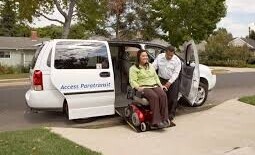
Access to reliable public transportation can be a game-changer for people with visual impairments, especially in rural areas where services are often limited. For those living in large cities, public transit options and assistive features like audible signals, tactile paths, and even specialized ride programs are usually more readily available. But in rural areas, the options are often fewer and the challenges greater, particularly when it comes to accessibility for those with low vision or blindness.
In this article, I’ll explore public transportation options and challenges for visually impaired individuals in rural areas, with a focus on paratransit services and other alternatives that can help foster independence and connectivity.
Public transportation is a lifeline for many, but in rural areas, its availability is spotty at best.
This makes life especially tough for those who can’t rely on sight. Accessing essentials like groceries, healthcare, or social outings becomes a complicated puzzle without adequate public transportation.
Visually impaired individuals in rural areas often need specialized services like paratransit. This service is crucial because it caters to people who can’t hop on a regular bus due to disabilities. Paratransit generally offers door-to-door services, significantly improving accessibility. Yet, its reach is limited in sparsely populated areas, leaving many without the support they need.
There are alternatives out there like community ride programs and specialized transit options. However, knowing about these, understanding eligibility, and navigating through the application process requires some grit and knowledge. In the sections to follow, we’ll explore these challenges and solutions in more detail, ensuring that your journey, or that of a loved one, is as smooth as possible.
Overview of Rural Transportation Challenges for the Visually Impaired
Rural living offers a quiet lifestyle with less congestion and more space, but it also brings unique transportation challenges, especially for those with disabilities. Here are some common barriers for visually impaired individuals in rural communities:
- Limited Public Transit Options: Many rural areas don’t have extensive bus or train services. Even if buses are available, routes may be infrequent and cover only specific areas, making it difficult to access key destinations like grocery stores, healthcare providers, or community centers.
- Longer Distances Between Locations: In rural regions, distances between home and essential services can be much farther than in urban areas, sometimes miles apart. Without a reliable personal vehicle or someone to assist with driving, visually impaired individuals may find it difficult to reach critical destinations independently.
- Limited Accessibility Infrastructure: Unlike urban transit systems, rural transportation may lack accessible infrastructure, such as tactile paths, Braille signage, or audible signals. These features are vital for safe, independent travel, but they’re often limited or absent in rural transportation systems.
The story doesn’t end there, though. Accessibility in these areas isn’t exactly top-notch. Imagine trying to find your way without tactile paths or audible signals to guide you. Even the latest transit apps can be less than helpful when they’re not tailor-made for visually impaired users.
All of this makes getting from point A to point B a real challenge. Being aware of these obstacles is super important for anyone looking to improve access or advocate for change. It’s also crucial for building systems that work better for everyone.
Understanding Paratransit Services in Rural Areas
For people who cannot use regular public transportation due to disabilities, paratransit services can provide an essential lifeline. Paratransit is designed to offer a flexible, accessible transportation option for people with disabilities, often with door-to-door or curb-to-curb service. However, paratransit availability in rural areas comes with its own set of challenges.
- What is Paratransit? Paratransit is a specialized transportation service mandated by the Americans with Disabilities Act (ADA) to provide equivalent transit for people with disabilities who cannot access regular public transportation. This typically includes wheelchair-accessible vehicles and additional accommodations as needed.
- Eligibility and Availability: To qualify for paratransit, individuals must meet specific criteria, which generally include an inability to use traditional public transit due to a disability. The application process typically involves filling out forms and may require documentation from a healthcare provider. Availability varies by region, and in rural areas, it’s often more limited due to funding or logistical challenges.
- Challenges of Rural Paratransit: Paratransit in rural areas faces distinct obstacles. Service areas can be restricted, meaning that some locations may not be covered. In many cases, paratransit services also require advance booking, sometimes as far ahead as 24 hours, which can limit flexibility. Additionally, because rural trips may cover long distances, costs can sometimes be higher for extended routes.
- How to Apply for Paratransit: If you believe you qualify, the application process usually begins with a phone call to your local disability services office, transportation authority, or transit provider. They will guide you through the required paperwork, and you may need verification from a healthcare provider to confirm your eligibility.
Exploring Transportation Solutions Beyond Paratransit

While paratransit plays a key role, other options out there can help bridge the gap for visually impaired people in rural settings. Community ride programs are worth checking out. These programs, like ‘Dial-a-Ride,’ often depend on local volunteers who pitch in to help folks get where they need to go. They’re a fantastic grassroots solution when mainstream options fall short.
Accessible ridesharing such as Lyft and Uber are becoming more of a thing, too. In some areas, rideshare companies partner with organizations to offer tailored services that cater to accessibility needs. These partnerships can make ridesharing a viable option, but availability tends to vary, so it’s best to see what’s on offer locally.
Then there’s Non-Emergency Medical Transportation, or NEMT. It might sound technical, but think of it as a service that gets you to and from medical appointments—and sometimes even to the grocery store or for a social visit. NEMT focuses on making sure you’re not stuck at home when you need to be somewhere important.
Specialized transit programs are another avenue to explore. Often supported by senior centers, disability organizations, or even local governments, these initiatives aim to provide reliable and budget-friendly travel. They’re particularly geared toward elderly or disabled riders, giving them a reliable way to connect with the broader community.
With all these options on the table, creating a personal transport plan becomes much more manageable. It’s all about finding what works in your area, understanding how to tap into these resources, and being proactive about weaving them into your daily routine.
Tips for Planning and Navigating Rural Transportation
When you’re traveling in a rural area with limited transit options, planning and flexibility are essential. Here are some strategies for navigating rural transportation effectively:
- Book Rides in Advance: For paratransit or community ride services, booking well in advance is crucial, especially if you have medical appointments or events with a set time. Some services require a full day’s notice, so planning can make a significant difference.
- Connect with Local Organizations: Disability resource centers, such as Centers for Independent Living (CILs), may provide transportation services or financial assistance for low-income riders. They may also offer guidance on other local transportation options and ways to advocate for better services.
- Consider Carpooling and Ride-Sharing with Friends or Neighbors: Many rural residents rely on informal networks for transportation. Consider setting up a regular carpool schedule with friends, family, or neighbors who may also be traveling to common destinations.
- Use Accessible Ride-Planning Apps and Tools: Though options may be limited, there are apps and tools available to assist with planning. GPS navigation apps and rideshare platforms can help you understand your travel options, even if traditional public transit apps are less helpful in rural areas.
